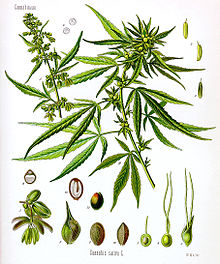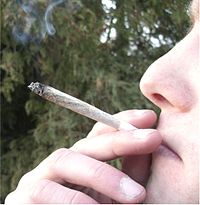Cannabis - Simple English Wikipedia, the free encyclopedia
| Cannabis | |
|---|---|
 | |
| Common hemp | |
| Scientific classification | |
| Kingdom: | Plantae |
| Clade: | Tracheophytes |
| Clade: | Angiosperms |
| Clade: | Eudicots |
| Clade: | Rosids |
| Order: | Rosales |
| Family: | Cannabaceae |
| Genus: | Cannabis L. |
| Species[1] | |
| |
Cannabis is a genus of plant. There are three species: Cannabis sativa, Cannabis indica, and Cannabis ruderalis.
The cannabis plant's flowers contain a chemical or drug known as THC (short for tetra-hydro-cannabinol). Smoking or eating the flower can make a person feel euphoric (very good) or sleepy. The plant is also used to make hemp fibre, and for its seeds and seed oil.
In its natural environment, THC's purpose was to protect itself against being eaten. There are many varieties of cannabis,[2] and those low on THC production are selected for producing hemp and seeds.
Since the 19th century, Cannabis has become an illegal drug in many countries. In the 21st century, some countries have made cannabis legal again. Others allow cannabis to be used as medicine when people have certain medical conditions.
Ancient history[change | change source]
Scientists believe that cannabis first grew somewhere in the Himalayas.[3] Evidence of people smoking cannabis goes as far back as prehistory: archaeologists have found burnt hemp seeds at a burial site in what is now Romania.[4] The most famous users of cannabis were the ancient Hindus, who called it ganjika in Sanskrit (ganja in modern Indian languages).[5] According to legend, the Indian god Shiva told his followers to worship the plant. The ancient drug soma was sometimes associated with cannabis.
People in the Persian Empire (what is now Iran) would light giant campfires made of cannabis, exposing themselves to the smoke. The ceremony was known as "the booz-rooz."[6]
Cannabis was also known in ancient Greece, where magicians would burn its flowers in order to cause strange thoughts in the audience members' minds. Historians think that the cult of Dionysus also began in ancient Greece and involved inhaling cannabis smoke.[5]
Drug effects[change | change source]
This section does not have any sources. (July 2023) |
When a person inhales cannabis smoke or consumes cannabis, he or she may get a feeling called "getting high" or "getting stoned". Cannabis's most common effects include feeling happy, relaxed, tired, silly or scared; having many ideas about what to do; not being able to think clearly (or remember some things at all); and getting hungry (also called getting "the munchies"). Smoking cannabis changes how people think and feel, making it either harder or easier to solve some problems. Some people who take cannabis feel strange or paranoid (worried that something bad is going to happen).
Hashish (dried resin) is much more concentrated than cannabis (it includes both leaves and flowers). Because of this, people who take large amounts of hashish may feel even stronger effects. They may also see things or hear things that do not exist (these are called hallucinations). They may also have strange thoughts. Some hashish users like the feeling of these visions and thoughts, while others may find them scary. However, people rarely get hallucinations after smoking or eating cannabis.
Legal status[change | change source]
Medical cannabis[change | change source]
In the 2010s many countries and some states in the United States made it legal for people with certain medical problems to use cannabis as a medicine. Medical use of cannabis is legal in Austria, Belgium, Canada, Chile, Colombia, the Czech Republic, Finland, Greece, Israel, the Netherlands, Spain and the United Kingdom. In March 2017 Germany legalised cannabis for medical use with treatment of pain and symptoms by chronic diseases.[7] Only a few companies and doctors in Germany willingly prescribe cannabis for medical uses. Not much known about the broad spectrum of medical cannabis efficacy as the drug is still listed under the German narcotics act (in German "Betäubungsmittelgesetz" or abbr. "BtMG").
In the United States, as of February 2018, 30 states, plus Washington, D.C. and Guam, had legalized medical cannabis. However, using cannabis for any reason is still illegal under federal law.[8][9]
According to a 1999 report by the Institute of Medicine, cannabis (especially THC) can decrease pain; control nausea and vomiting; and improve appetite.[10] As of June 2016, according to the National Conference of State Legislatures, "Further studies have found that cannabis [helps] some of the symptoms of HIV/AIDS, cancer, glaucoma, and multiple sclerosis.[8]
Personal use[change | change source]
On December 11, 2013, Uruguay was the first country in the world to make it legal to grow, sell, and use cannabis for personal (or recreational) use.[11] Other countries that allow people to have small amounts of cannabis (just enough for them to use personally) include Colombia, Ecuador, Jamaica, the Netherlands, Peru, Portugal, Spain, and Switzerland.[12] In the United States, on January 1, 2014, the states of Washington and Colorado made it legal for people aged 21 or older to buy cannabis.[13] In November 2016, California did the same thing, and has been selling cannabis in stores since January 2018.[14] As of October 17th, 2018, Canada has become the first G7 nation to make cannabis legal.[15] Each province of Canada has its own legal minimum age to buy and use (either 18-years-old and older, 19-years-old and older, or 21-years-old and older) and how much of it is allowed to have at one time.[16]
Health risks[change | change source]

Cannabis is one of the least dangerous of the commonly used illegal drugs. It is almost impossible to overdose on cannabis. A person would have to smoke their entire body weight in five minutes in order to overdose.[17][18][19][20]
As of 1995, scientists had not shown that smoking cannabis causes lung cancer, even in people who smoke a lot of cannabis for a long time.[21][22]
It is a common, yet false, belief that people who use cannabis are less interested in life and may not want to go to school or work (scientists call this "amotivational syndrome"). However, many reports show that people who use cannabis do just as well as non-users.[23][24]
Driving while "stoned"[change | change source]
A person who is intoxicated ("high" or "stoned") from cannabis could get hurt or killed in an accident if they drive a car. It is not safe to drive under the influence of any intoxicant. However, drivers who are "stoned" are much less likely to get into car accidents than drunk drivers and in some cases, sober drivers.[25][26]
Addiction[change | change source]
"Hard drugs", such as heroin, meth, and cocaine, are chemically addictive. This means that if a person starts taking heroin, meth, or cocaine, that person's body will physically need to keep taking the drug. If they try to stop using the drug, they may become very sick. Cannabis and hashish are not chemically addictive, but they can be psychologically or habitually addictive. This means that people can get so used to the pleasure cannabis causes that they feel as if they need the drug. Unlike with alcohol, tobacco, and hard drugs, most people who use cannabis can stop taking it when they want, while experiencing only minor withdrawal symptoms. However, while cannabis[27] may not be as addictive as other drugs, people can still become very much addicted to the pleasure of cannabis.[28]
Related pages[change | change source]
References[change | change source]
- ↑ Geoffrey William Guy; Brian Anthony Whittle; Philip Robson (2004). The Medicinal Uses of Cannabis and Cannabinoids. Pharmaceutical Press. pp. 74–. ISBN 978-0-85369-517-2.
- ↑ Small E 1975. American law and the species problem in Cannabis: science and semantics. Bulletin on narcotics 27 (3): 1–20.
- ↑ Marijuana and the Cannabinoids", ElSohly(p.8)
- ↑ Rudgley, Richard (1998). Lost civilisations of the Stone Age. New York: Free Press. ISBN 0-684-85580-1.
- ↑ 5.0 5.1 Miller, Ga (1911). Encyclopædia Britannica. 34 (11th ed.). 761–762. doi:10.1126/science.34.883.761
- ↑ Ibn Taymiyya (2001). Le haschich et l'extase. Beyrouth: Albouraq. ISBN 2841-61174-4
- ↑ "Cannabis für die Psyche gesund? Folgen von THC und CBD". www.algeacare.com (in German). 26 April 2022. Retrieved 2022-05-14.
- ↑ 8.0 8.1 "State Medical Marijuana Laws". National Conference of State Legislatures. June 8, 2016. Retrieved June 13, 2016.
- ↑ "State Marijuana Laws in 2018 Map". www.governing.com. 7 November 2012. Retrieved 2018-02-17.
- ↑ Marijuana and Medicine: Assessing the Science Base. The National Academies Press. 1999. ISBN 978-0-309-07155-0.
{{cite book}}: Cite uses deprecated parameter|authors=(help) - ↑ "Uruguay becomes first country to legalize marijuana trade". NBCNews.com. Retrieved December 11, 2013.
- ↑ Brant, Emma (October 30, 2014). "Where in the world can you legally smoke cannabis?". BBC. Retrieved June 13, 2016.
- ↑ CNN, By Michael Martinez (28 December 2013). "10 things to know about Colorado's recreational marijuana shops". CNN.
{{cite web}}:|last=has generic name (help) - ↑ Fuller, Thomas (2018). "Recreational Pot Is Officially Legal in California". The New York Times. ISSN 0362-4331. Retrieved 2018-04-04.
- ↑ Kassam, Ashifa (2017-03-27). "Canadian government aims to legalise marijuana by 1 July 2018". the Guardian. Retrieved 2018-04-04.
- ↑ "Introduction of the Cannabis Act: questions and answers". Government of Canada. 6 March 2018. Retrieved 2018-04-04.
- ↑ "Health Education | Marijuana". Retrieved 2009-03-29.
- ↑ "Medical Marijuana Keystone Document". Archived from the original on 2009-02-27. Retrieved 2009-03-29.
- ↑ "How Marijuana Can Kill You: Why a Cannabis Overdose is Impossible". Archived from the original on 2011-07-23. Retrieved 2009-03-29.
- ↑ "Cannabinoid Overdose: Is It Possible". Retrieved 2022-10-02.
- ↑ Turner, Carlton E. The Marijuana Controversy. Rockville: American Council for Drug Education, 1981.
- ↑ "Deglamorising cannabis". The Lancet. 346. November 1995.
- ↑ Himmelstein, J.L. (1983). The Strange Career of Marihuana: Politics and Ideology of Drug Control in America. Westport, CT: Greenwood Press. ISBN 0313235171.
- ↑ Pope, H.G. et al., “Drug Use and Life Style Among College Undergraduates in 1989: A Comparison With 1969 and 1978,” American Journal of Psychiatry 147 (1990): 998-1001.
- ↑ Moskowitz, Herbert; Petersen, Robert (1982). "Marijuana and Driving: A Review". American Council for Drug Education.
- ↑ Sewell, R. Andrew; Poling, James; Sofuoglu, Mehmet (2009). "The Effect of Cannabis Compared with Alcohol on Driving". The American Journal on Addictions / American Academy of Psychiatrists in Alcoholism and Addictions. 18 (3): 185–193. doi:10.1080/10550490902786934. ISSN 1055-0496. PMC 2722956. PMID 19340636.
- ↑ Miller, Carol. "CBD Facts and Myths that You Should be Aware Of". THCClubHouston.com. Retrieved 9 February 2022.
- ↑ "'Compass Of Pleasure': Why Some Things Feel So Good". NPR. Retrieved 2011-10-27.


 French
French Deutsch
Deutsch